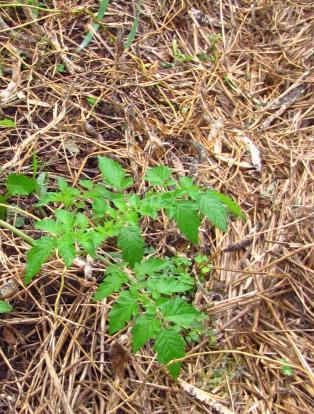Seed catalogs sell a lot of F1 hybrids: crosses between two inbred lines. Inbreeding sounds pretty icky (I hope), but in garden plants we don’t really worry about it. Inbred lines are kept genetically isolated: they’re not allowed to have funny business with anybody but themselves. This makes them reservoirs of traits: very hairy leaves, purple tomatoes, big teeth etc.
When the breeder then crosses inbred line 1 (say a cherry tomato with great disease resistance) and inbred line 2 (a big juicy red tomato that wilts over and dies at the first sign of blight) she gets a hybrid that mixes traits from the two (e.g. a big tomato with disease resistance). Because the inbred lines are known quantities, the resultant hybrid will have predictable traits. So when I order “Defiant” seeds, I know what I’m going to get.
Tomato breeding is an example of artificial selection. That’s not to say that all plant breeders are artificial. The few agricultural plant breeders I’ve known have been really solid people with few artificial components beyond teeth. Not like, you know, Cher.
So what about those volunteer tomatoes that come up every year? Is that an example of natural or artificial selection? Should I get better tomatoes from those? By the time I notice them they are pretty big and healthy. The weak ones have died. Through whatever process, their parents were reproductively successful: the seeds survived a New England winter.

But what should I expect from these tomatoes?
Wild tomatoes use bees to fertilize each other. Cultivated tomatoes are self-fertile but require the intervention of wind or bumblebees to do the deed. Of course when the bumblebee visits the flower, she’ll pick up some pollen and take it to another tomato flower — there will be some crossing. The seeds in garden tomatoes therefore are a mixture of hybridization and self pollination. This doesn’t affect fruit quality in the first generation, but it means the next generation’s seedlings could vary quite a bit and therefore their fruit will be affected.
In years past I have let a few of these volunteers set fruit. They’re almost always cherry tomatoes and not very tasty. What would happen if I planted the seeds from these tomatoes? Well, I’d get a mixture again, and the only thing I would have selected for is the ability to withstand a New England winter, not taste, not disease resistance, and not size.
When you focus your selection without awareness of lots of different traits, you wind up losing important genetic background. This is why the robust grocery store tomato is so tasteless and blemish free. It’s also why a fair number of purebred dogs need c-sections (e.g. the Boston terrier).
Hybrids in dogs of course aren’t always “planned.” Dogs are notorious for their poor family planning choices. Sometimes a neighborhood dog and a pedigreed pooch meet and find they have a lot in common (scratching their intimate bits in public, smelling nasty things), one thing leads to another and pretty soon she’s in a family way. I feel the results of these unintentional dog mixes usually turn out fine. My rather radical opinion is that mutts make better pets than purebreds. They tend to be a bit brighter and less barky. They may not have increased reproductive fitness, but that’s not what I look for in a dog (or cat). Actually I pretty much look for the opposite of that and take surgical steps to ensure a lack of reproductive fitness. Dogs, though, are not tomatoes. In plants these happy accidents don’t usually turn out so well, so I pull the volunteers mercilessly.


